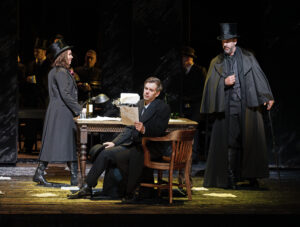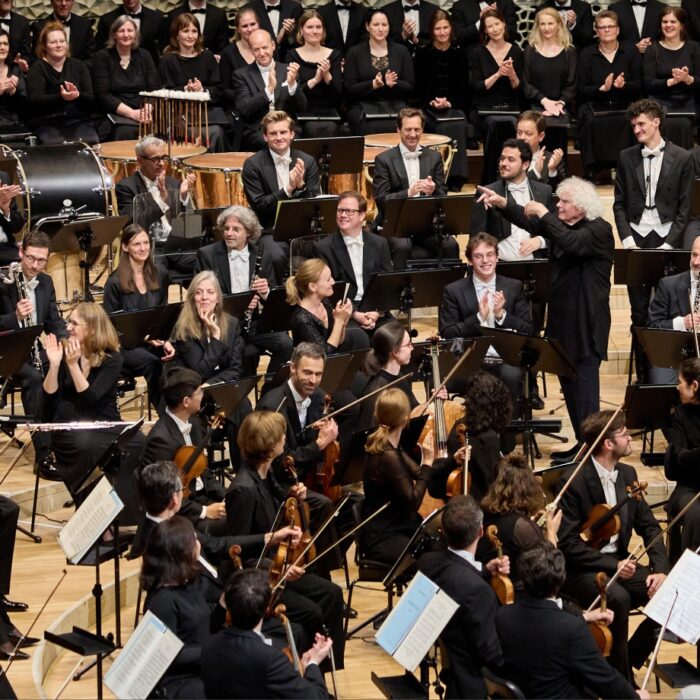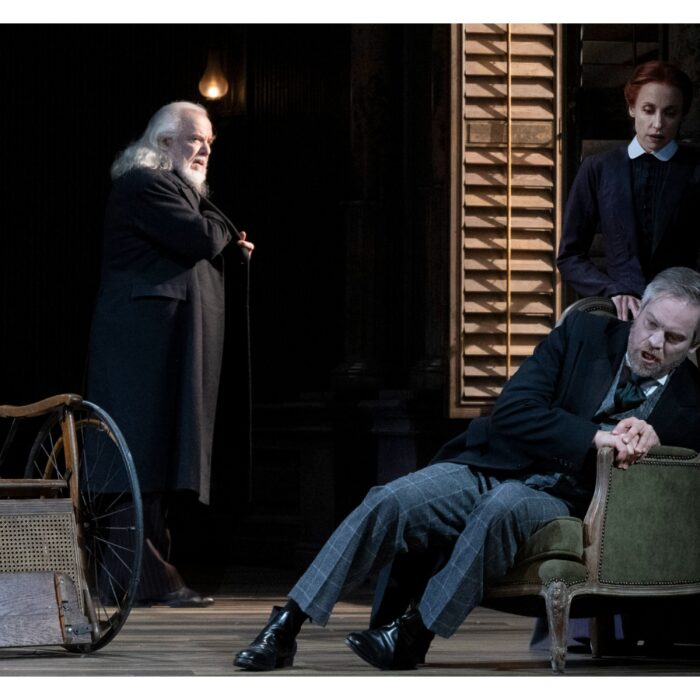
Metropolitan Opera 2024-25 Review: Les Contes d’Hoffmann
Led by Benjamin Bernheim & Christian Van Horn, This Production Saves the Best for Last
By David Salazar(Credit: Ken Howard / Metropolitan Opera)
(This review was written in collaboration with Francisco Salazar)
After a hyped but underwhelming opening night, the Met Opera’s second at-bat in the 2024-25 was the revival of a French classic that it hadn’t showcased since 2017.
“Les Contes d’Hoffmann” is an incredible opera, rich in imagination, both in its musical and dramatic qualities. It is comic and colorful, but also deeply dark and disturbing. It can be a director’s dream. The Met’s revival of Bartlett Sher’s production was a reminder of the artistic limitation present at the theater during the current administration.
Stunted Imagination
Sher is what I call a “Peter Gelb director” (Michael Mayer, who helmed “Grounded” is another). He’s among the stable of metteurs-en-scène that had success in other media, notably Broadway, and came to the Met during Gelb’s regime and have remained fixtures there, the goal likely to bring their Broadway fans with them. From there, these directors have essentially restaged not only new works, but some of the major classics, lending a “new” identity to the Met Opera stage. The results have often been mixed mainly because as great as these directors were elsewhere, somewhere along the line, opera simply hasn’t suited their skillset.
I bring this up because a week ago I was fortunate to see previews for “MacNeal,” a play starring Robert Downey Jr., no doubt the main draw. But surprising for me was how excellent the production was on the whole. The director? Bartlett Sher. Never having seen the director’s “non-opera” work, I was shook. For here was someone who was blowing me away after having never been impressed by any of his work on the Met stage. On some level, the argument could be that opera is just completely different from other theatrical art forms and the skills that work in one are not completely transferable to the other. Or that Gelb expected Broadway results from his directors without giving them the Broadway resources to do it.
“Hoffmann” feels like Sher was grasping for more than he could get because while the production has some striking visual moments and is “pretty” on the whole, it really comes off as an exercise in style over substance, the parts never really coalescing into a poignant or potent whole. I remember in the run-up to the production’s unveiling well over a decade ago (when the main story was about the constant casting reshuffling with Rolando Villazón dropping out followed by Elina Garanca, etc.) there was a lot of talk about Fellini this and Fellini that. It was a weird comparison, even if the final act is set in Venice and undeniably features a musical approach akin to the great Italian operas contemporary to Offenbach. But the sense of unpredictability that a Fellini film produces, the sense of magic paired with mundanity, never really shines in this production. There’s a lot of surrealism here, but surrealism for the sake of surrealism without a grander connective tissue usually doesn’t lead anywhere.
Nicklausse and Lindorf seem to be in alliance with one another to derail Hoffmann’s romances so he can get back to writing, symbolized by an omnipresent empty desk that needs filling on stage left (and eventually – SHOCKING SPOILER ALERT – does). We understand why Nicklausse wants this, but Lindorf’s motivations are never clear in this regard and the entire thing comes off as forced. It’s Sher’s one original idea in the entire production which plays everything else pretty straight, but just colored and crowded up for maximum effect. I give him credit in this regard because he knows the Met audience wants pomp and circumstance and he does the best he can to give, especially during Act one with its pink and red color scheme. The blue of Act two provides a mellow contrast and suits the shift in tone and the eeriness of the ghost story taking place. Act three is just full of black, exactly like the prelude and epilogue, making it the least visually striking of the three sets and also the one that feels most undercooked mainly because of the next point.
Going back to “MacNeal,” staging blocking felt so precise and yet free in that play. As a viewer, there was never any doubt of where you should look or where your attention was being directed.
The blocking in “Hoffmann” feels static and lacking in intention and the results are characters that lack a sense of clarity. You often don’t know where to look or what to follow because of all the clutter. Ironically, Act three was where the production was messiest in this regard and yet, because it was undoubtedly strongest musically, it somehow worked.
Sher’s greatest success at the Met were his Rossini operas – “Il Barbiere di Siviglia” and “Le Comte Ory” precisely because he knew how to manage the actors around the stage, their personalities allowed to come through. There’s always a feeling that there’s more to do here that has yet to be unlocked.
The Best for Last
Taking on the mantle of the title role was Benjamin Bernheim who was coming off a run in Salzburg just last month. He performed the role in December to extraordinary results in Paris this past holiday season and this was the first opportunity the Met Opera was getting to see the tenor in one of his signature roles. And he undeniably delivered throughout, but he undoubtedly saved the best for last.
Through the first two acts and prelude, there was little you could fault about Bernheim’s performance. The singing was pristine, the connective tissue between the highs and middle of his voice polished and elegantly delivered. No one else’s French came through with the clarity as his did, no small feat in a massive hall where a lot of people could care less what language is being sung in (I make this claim because I’ve heard that excuse in a lot of conversations in defense of singers whose control of certain languages is not top tier). The “Kleinzach” aria had rhythmic precision and propulsion and the tenor rode the wave of the lyric “Ah! sa figure était charmante,” a passage that rises and rises up the tenor tessitura, the orchestra gaining in strength in the process. But there was a reserve in this interpretation that hadn’t been there in the Paris performances.
He maintained that during the first Act with Olympia, and even during the Antonia act, his singing gentle though gleaming in its upper range. Having heard Bernheim in “Roméo et Juliette” and “Rigoletto” at the Met, it was surprising that throughout these early acts, the tenor and the orchestra never quite found a balance together with the ensemble often overpowering him. This is not something I heard in Paris. Moreover, the production has Hoffmann standing on the margins for a great deal of his own story and because of all the visual clutter, he can easily get lost in the mix. Nonetheless, Bernheim’s was a perfectly solid interpretation for two acts and a prelude.
But alas, then came Act three. And this is where Bernheim reached dramatic and vocal heights that I think might have even exceeded those he had in Paris. For here was a truly tormented Hoffmann, clearly broken from his previous misadventures. His “Et moi, ce n’est pas là, pardieu!” immediately had a bite that nothing else to that point had. “Plaisir” was thrown off less like an excited cry than one of coming rage. “Amis, l’amour tendre et rêveur” was thrown off with a repressed aggression that would later take flight in the final “Kleinzach.” This Hoffmann was a raging drunk on the verge of being unleashed. “O Dieu! de quelle ivresse” was an impassioned plea, Bernheim’s voice shining at its most potent in the Met house, crescendoing with each phrase, the sound blossoming more and more, the intensity cranked to its utmost.
And yet there was even more for Bernheim to give in the big concertato at the close of the piece, where visibly distraught, almost hugging himself in pain, his voice found yet another gear. In Paris, the concertato “Hélas! Mon coeur s’égare” proved a moment of introspection for Bernheim vocally. But here, he was full of remorse, heart on his sleeve, the opening phrase soft, but almost like a vocal weep. Then the voice took on a more pointed turn on “Maudit l’amour” the voice rising, Hoffmann’s anguish given greater power. The tenor never let up from this point on. This was the moment where Bernheim truly asserted his presence in this performance and it was impossible to look away from him. As the ensemble exploded with more and more voices and a stronger orchestra, his voice remained ever-present, riding over everyone cleanly and beautifully. His “Miserable” at the close of the Act was a furious cry that resonated in stark contrast to any of the other reactions to losing Olympia and Antonia.
In the epilogue, Bernheim gave into Hoffmann’s fractured sense of self, his erratic movements playing up his loss of emotional and physical control, his singing taking on a harsher and more accented color. As he remembered the three loves of his life, the tenderness of those first two acts returned, but when the final “Kleinzach” returned, the tenor donned the white “cape” and skidded around, the repressed anger given vocal expression in undeniably his most captivating rendition of the piece on the night. And with that final high note at the close of the aria, he fell to the ground, revived moments later in the final ensemble that this production employs.
This is a world-class turn as Hoffmann, with the best saved for last.
In League?
Speaking of world-class, let’s talk about Christian Van Horn. He was also in those Paris and Salzburg runs with Bernheim and also had immeasurable success as “the Villains.” When he’s onstage, he towers over everyone like a God, strutting around like he owns the place. But the production doesn’t seem to know what to do with his character half the time and the evil is never truly manifested. The big issue is the cognitive dissonance of his being seemingly portrayed as in league with Nicklausse, who we know to be the muse in disguise who seeks to help Hoffmann. So it makes him less of a force of evil or antagonism, and more a henchman for a bigger villain. And since Nicklausse never comes off as particularly intimidating, the entire enterprise falls apart.
Nonetheless, Van Horn’s vocal presence makes you shudder. All he needs to do is open his mouth and cackle to make you laugh from the nervous energy it produces. There’s always bite and venom in his singing, the robust bass-baritone jagged in its articulation. He was at his most snake-like in Act two, creeping about, haunting Antonia. You could almost feel a hiss in the way he was goading her. Once he had control over her, his voice erupted with potency and he carried the ensuing trio with abandon (in fact he carried both trios in this act; to say that he was the star of Act two is a massive understatement).
And then there was Act three, where everyone seemed to be at their best. The villain here, Dapertutto gets a glorious aria “Scintille, diamante” and Van Horn made the most of it. If in Paris he displayed a glorious gentleness in this moment, here he gave full reign to muscularity, his voice growing and growing throughout the aria, each line building on itself to an ecstatic climax. Given its size, potent vocal displays always reign supreme for Met audiences. This was the greatest exponent of that kind of bravura on the night.
In the role of the Muse and Nickclausse, Vasilisa Berzhanskaya was making her Met debut. The 30-year-old mezzo has become a major force in the bel canto repertoire in Europe ever since her breakout in Pesaro in “Moïse et Pharaon” in 2021. So it was an interesting choice to give the mezzo something she rarely does for her Met debut – a French pants role. Berzhanskaya took her time to warm up to the role and the language. Her opening aria, while sung with a gorgeous lyric color, sounded tentative and as she rose to the higher ranges of the voice, she struggled to make it ring. The first two acts also saw the mezzo a bit uncomfortable in attempting comic timing and swagger.
In Act two, Berzhanskaya showed off her comic timing, coloratura precision and some interpolated high notes as she reminded Hoffmann of Olympia. Here we got a glimpse of what the mezzo could potentially do in a bel canto role if the Met is to bring her back. But in the ensuing “Vois sous l’archet frémissant,” the mezzo struggled to connect the lines with a true legato. The phrases were choppy, especially in the second repeat, the tempo plodding (a surprise because the tempo was generally pretty swift throughout the time). Her low notes turned hollow and as the orchestra crescendoed to its climax, she struggled to equal its power and movement. Only at the end, did she recover with a gorgeous high note.
In Act three Berzhanskaya finally found her stride with a warm barcarolle bringing out the smoothness of her voice and blending the irresistible melody with Clémentine Margaine’s fuller sound. The contrasting timbre worked perfectly with Berzhanskaya emphasizing the more romantic side of the piece while Margaine brought out the allure of her character through her lower notes. At the end of the duet as they repeated “amour,” Berzhanskaya’s voice took on a velvety quality as she diminuendoed to end the piece. It was truly irresistible singing. And in the epilogue, as she began the final ensemble, the voice rang out into the theater with a yearning quality. Berzhanskaya is a talent to look out for and one hopes that as the run continues she will get more comfortable in the role.
Three Very Different Lovers
In the role of Olympia, Erin Morley returned to the production which she sang back in 2015 and 2017. It’s a role that has brought her great success and on this evening it was no different. The opening of “Les oiseaux dans la charmille” was sung with precise coloratura and a flexible top. Morley did this all while dancing and moving around the stage like a robot. Then as she commenced the second verse, Morley added several interpolated high notes all while dancing around the stage; those familiar with the usual ornaments in this piece will be surprised just how much Morley pushed the envelope here with her additions. She was toying with expectations to tremendous success. The voice moved smoothly through the vocal line and the interpolated high notes rang with ease into the theaters, receiving a thunderous applause at the end.
In her ensuing scene with Hoffmann as he sings his heart out to the mechanical doll, Morley’s blank stare added to the absurdity of the circumstance and in their waltz, she danced with precise steps. In her following entrance which is essentially a coloratura vocalise, Morley dispatched the phrases with ease as she continuously fell to the floor and repeatedly got up and then moved about the stage. It was the true embodiment of a malfunctioning doll and a full-on virtuosic display.
Less virtuosic was Pretty Yende in the role of Antonia, a part she has previously done at the Palau de les Arts and Staatsoper Hamburg when she sang all four heroines. For the soprano, this was her return to the Met for the first time since 2019 and a lot has changed for her vocally. Her instrument has become heavier and it is evident that the soprano has issues finding the right balance between her lighter side and more voluminous portions. As she increases the volume and ascends to the higher reaches of her voice, the timbre becomes strident and harsh and often suffers pitch issues. You never know what you’re going to get and it builds an uncomfortable tension to listen to. Unsurprisingly, on this night, Yende had mixed results. And it started right away with her opening aria “Elle a fui, la Tourterelle.” Every ascension into the passaggio and beyond was met with an unpredictable wobble, the intonation consistently off. This settled in her middle range as retreated to the softer and lighter phrases. The “Chère fleur qui viens d’éclore” saw Yende sing with an even softer and smoother sound that she relished.
Her duet with Bernheim was a mixed bag particularly as the duet lacked a dynamic chemistry that took away from the tenderness of the piece. In the opening of the duet, Yende sang “Ah! j’ai le bonheur dans l’âme!” with drive even though the high notes were harsh and intonation was adventurous. Her “Viens là, comme autrefois” saw a bright shimmery sound that highlighted the soprano’s flexibility and gleaming high notes. And in the ensuing second melody “Tour à tour; C’est une chanson d’amour,” Yende retained a light sound that balanced well with Bernheim and showcased the creaminess of her voice.
But things took a turn at the end of the act. One of the most famous ensembles of Hoffmann is the Act two trio in which Antonia becomes possessed by the music and can’t resist the urge to sing. The trio builds and builds as does the orchestra and the mezzo and bass lines. However, the soprano is the leading line and as mentioned, Van Horn was the one driving the passage. The reason was that Yende’s voice failed to capture the urgency and feverish urges of Antonia’s singing. Her voice was drowned by her ensemble members and as the ensemble continued to the climax, it fizzled out with weak final high notes. That being said she was committed to the madness of the scene through her physicality.
Her final phrases “C’est une chanson d’amour …Qui s’envole …” were beautifully sung but unfortunately undercut by the lack of power in the prior trio. And in the final Act three ensemble, Yende’s voice blended well with the rest of the ensemble showcasing a gleaming sound.
Clémentine Margaine made her role debut as Giulietta. From the moment the mezzo stepped on the stage, she commanded the listener with her seductive and gigantic mezzo. While there were balance issues with Bernheim’s voice in their duet “Si ta présence m’est ravie,” Margaine exuded a sultry vocal quality. While sometimes unbalanced at the top, her mezzo was always imposing and gave the duet a sense of urgency. In the sextet, Margaine also overpowered the entire ensemble, and as mentioned in the barcarolle, she brought back her sound and melded beautifully with Berzhanskaya. Watching Margaine, I wondered why the Met hasn’t brought this powerful singer for some more dramatic roles. Here is to hoping they give this major singer meatier roles.
In the role of Antonia’s mother, Eve Gigliotti brought a powerful mezzo to the trio in Act two while Bradley Garvin, Tony Stevenson, and Jeonhcheol Chia were fantastic in their supporting roles.
Aaron Blake put on a showstopper in Act two with his “Jour et nuit je me mets en quarte.” The tenor really milked the piece for all its worth, showcasing some beautiful and even hilarious high notes. He twirled about during the second section of the aria and clearly had a great old time. So did the audience, which received him with the first major ovation of the second Act.
Italianate Offenbach?
In the pit, Marco Armiliato led the Met Orchestra in a strange approach to the opera. “Hoffmann” is a French work and while there are some other musical styles present throughout, it is decidedly not a 19th century Italian opera (though one could make an argument for Act three containing a lot of those elements). And yet, it felt a lot like one under the Maestro’s baton, the orchestra propulsive and frenzied in its energy. It felt a bit boisterous throughout (though exciting), overwhelming the singers and not allowing them the space to make more of the flexibility, elegance, and even introspection found in Offenbach’s music. Balance issues were present throughout the first two acts with the male trio in Act two noticeable – none of the three voices were present with the orchestra running roughshod over them. But yes, as mentioned, Act three was where Armiliato’s approach bore its fruits, with the intensity allowed to reign free and all the singers there to match it in spades. It was undeniably the musical coup of the night and the opera drove that momentum all the way to a truly satisfying conclusion.
If you want star power, this one has it. And hopefully, as the run progresses, the shortcomings will be overcome, new comfort will be found, and the highs will soar to greater depths.


